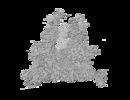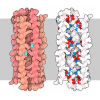登録情報 データベース : EMDB / ID : EMD-7516タイトル BG505 SOSIP in complex with sCD4, 17b, 8ANC195 cryoEM map of BG505 SOSIP in complex with sCD4, 8ANC195, 17b 複合体 : BG505 SOSIP in complex with sCD4, 17b, 8ANC195タンパク質・ペプチド : Envelope glycoprotein gp160タンパク質・ペプチド : Envelope glycoprotein gp160タンパク質・ペプチド : T-cell surface glycoprotein CD4タンパク質・ペプチド : 17b Fab light chainタンパク質・ペプチド : 17b Fab heavy chainタンパク質・ペプチド : 8ANC195 Fab heavy chainタンパク質・ペプチド : 8ANC195 Fab light chainリガンド : 2-acetamido-2-deoxy-beta-D-glucopyranose / 機能・相同性 分子機能 ドメイン・相同性 構成要素
/ / / / / / / / / / / / / / / / / / / / / / / / / / / / / / / / / / / / / / / / / / / / / / / / / / / / / / / / / / / / / / / / / / / / / / / / / / / / / / / / / / / / / / / / / / / / / / / / / / / / / / / / / / / / / / / / / / / / / / / / / / 生物種 / Homo sapiens (ヒト)手法 / / 解像度 : 3.54 Å Wang H / Bjorkman PJ 資金援助 Organization Grant number 国 National Institutes of Health/National Institute Of Allergy and Infectious Diseases (NIH/NIAID) HIVRAD P01 AI100148
ジャーナル : Cell Host Microbe / 年 : 2018タイトル : Partially Open HIV-1 Envelope Structures Exhibit Conformational Changes Relevant for Coreceptor Binding and Fusion.著者 : Haoqing Wang / Christopher O Barnes / Zhi Yang / Michel C Nussenzweig / Pamela J Bjorkman / 要旨 : HIV-1 Env, a trimer of gp120-gp41 heterodimers, mediates membrane fusion after binding host receptor CD4. Receptor binding displaces V1V2 loops from Env's apex, allowing coreceptor binding and ... HIV-1 Env, a trimer of gp120-gp41 heterodimers, mediates membrane fusion after binding host receptor CD4. Receptor binding displaces V1V2 loops from Env's apex, allowing coreceptor binding and opening Env to enable gp41-mediated fusion. We present 3.54 Å and 4.06 Å cryoelectron microscopy structures of partially open soluble native-like Env trimers (SOSIPs) bound to CD4. One structure, a complex with a coreceptor-mimicking antibody that binds both CD4 and gp120, stabilizes the displaced V1V2 and reveals its structure. Comparing partially and fully open Envs with closed Envs shows that gp41 rearrangements are independent of the CD4-induced rearrangements that result in V1V2 displacement and formation of a 4-stranded bridging sheet. These findings suggest ordered conformational changes before coreceptor binding: (1) gp120 opening inducing side-chain rearrangements and a compact gp41 central helix conformation, and (2) 4-stranded bridging-sheet formation and V1V2 displacement. These analyses illuminate potential receptor-induced Env changes and inform design of therapeutics disrupting viral entry. 履歴 登録 2018年3月2日 - ヘッダ(付随情報) 公開 2018年5月30日 - マップ公開 2018年10月17日 - 更新 2025年5月14日 - 現状 2025年5月14日 処理サイト : RCSB / 状態 : 公開
すべて表示 表示を減らす
 データを開く
データを開く 基本情報
基本情報 マップデータ
マップデータ 試料
試料 キーワード
キーワード 機能・相同性情報
機能・相同性情報
 Human immunodeficiency virus 1 (ヒト免疫不全ウイルス) /
Human immunodeficiency virus 1 (ヒト免疫不全ウイルス) /  Homo sapiens (ヒト)
Homo sapiens (ヒト) データ登録者
データ登録者 米国, 1件
米国, 1件  引用
引用 ジャーナル: Cell Host Microbe / 年: 2018
ジャーナル: Cell Host Microbe / 年: 2018
 構造の表示
構造の表示 ムービービューア
ムービービューア SurfView
SurfView Molmil
Molmil Jmol/JSmol
Jmol/JSmol ダウンロードとリンク
ダウンロードとリンク emd_7516.map.gz
emd_7516.map.gz EMDBマップデータ形式
EMDBマップデータ形式 emd-7516-v30.xml
emd-7516-v30.xml emd-7516.xml
emd-7516.xml EMDBヘッダ
EMDBヘッダ emd_7516_fsc.xml
emd_7516_fsc.xml FSCデータファイル
FSCデータファイル emd_7516.png
emd_7516.png emd-7516.cif.gz
emd-7516.cif.gz http://ftp.pdbj.org/pub/emdb/structures/EMD-7516
http://ftp.pdbj.org/pub/emdb/structures/EMD-7516 ftp://ftp.pdbj.org/pub/emdb/structures/EMD-7516
ftp://ftp.pdbj.org/pub/emdb/structures/EMD-7516 emd_7516_validation.pdf.gz
emd_7516_validation.pdf.gz EMDB検証レポート
EMDB検証レポート emd_7516_full_validation.pdf.gz
emd_7516_full_validation.pdf.gz emd_7516_validation.xml.gz
emd_7516_validation.xml.gz emd_7516_validation.cif.gz
emd_7516_validation.cif.gz https://ftp.pdbj.org/pub/emdb/validation_reports/EMD-7516
https://ftp.pdbj.org/pub/emdb/validation_reports/EMD-7516 ftp://ftp.pdbj.org/pub/emdb/validation_reports/EMD-7516
ftp://ftp.pdbj.org/pub/emdb/validation_reports/EMD-7516 リンク
リンク EMDB (EBI/PDBe) /
EMDB (EBI/PDBe) /  EMDataResource
EMDataResource マップ
マップ ダウンロード / ファイル: emd_7516.map.gz / 形式: CCP4 / 大きさ: 103 MB / タイプ: IMAGE STORED AS FLOATING POINT NUMBER (4 BYTES)
ダウンロード / ファイル: emd_7516.map.gz / 形式: CCP4 / 大きさ: 103 MB / タイプ: IMAGE STORED AS FLOATING POINT NUMBER (4 BYTES) 試料の構成要素
試料の構成要素
 Human immunodeficiency virus 1 (ヒト免疫不全ウイルス)
Human immunodeficiency virus 1 (ヒト免疫不全ウイルス)
 Human immunodeficiency virus 1 (ヒト免疫不全ウイルス)
Human immunodeficiency virus 1 (ヒト免疫不全ウイルス) Homo sapiens (ヒト)
Homo sapiens (ヒト)
 Human immunodeficiency virus 1 (ヒト免疫不全ウイルス)
Human immunodeficiency virus 1 (ヒト免疫不全ウイルス) Homo sapiens (ヒト)
Homo sapiens (ヒト) Homo sapiens (ヒト)
Homo sapiens (ヒト) Homo sapiens (ヒト)
Homo sapiens (ヒト) Homo sapiens (ヒト)
Homo sapiens (ヒト) Homo sapiens (ヒト)
Homo sapiens (ヒト) Homo sapiens (ヒト)
Homo sapiens (ヒト) Homo sapiens (ヒト)
Homo sapiens (ヒト) Homo sapiens (ヒト)
Homo sapiens (ヒト) Homo sapiens (ヒト)
Homo sapiens (ヒト) Homo sapiens (ヒト)
Homo sapiens (ヒト) Homo sapiens (ヒト)
Homo sapiens (ヒト)
 解析
解析 試料調製
試料調製 電子顕微鏡法
電子顕微鏡法 FIELD EMISSION GUN
FIELD EMISSION GUN
 ムービー
ムービー コントローラー
コントローラー
































 Z (Sec.)
Z (Sec.) Y (Row.)
Y (Row.) X (Col.)
X (Col.)






















